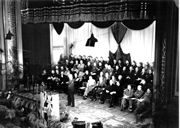
Assessment - Curtin as an election leader
Curtin’s record as a party leader conducting general election campaigns looks much better in hindsight than it did along the way. In assessing his first test on the hustings in October 1937 Curtin’s biographer David Day suggests that ‘the results did not bode well for his continuing tenure’ as Leader of the Labor Party. 82 After a disastrous election in 1931 the ALP had won back four House of Representatives seats in the 1934 election when led by Scullin but then only two in 1937 with Curtin at the helm. Paradoxically, however Labor won 16 of the 19 Senate seats being contested: as previously indicated this probably reflected a wish by electors to register a protest vote without jeopardizing the UAP government. At the same time, the parliamentary presence of these Senators whose term did not expire until 30 June 1944 was of great value to Curtin during the first two years of his prime ministership In terms of Curtin’s own contribution in the 1937 campaign Day suggests that he ‘kept up a gruelling pace during the election . . . spending an average of ten hours a day in trains’ while the emphasis in his speeches was no longer centred on the class war images of his youth but on the people’s ‘common identity as Australians’. 83
If the 1937 results were somewhat mixed the 1940 election was especially anomalous given that, on the one hand, Curtin and the ALP came within two seats of having a majority in its own right in the House but with its greatest area of success in New South Wales where the party had the most obvious internal divisions. Moreover, Curtin himself almost lost his own seat, a factor almost certainly due to his focus on the national campaign at the expense of shoring up support in Fremantle. Day has described the outcome as a ‘triumph for labor’ 84 but in many respects Labor’s improvement in its vote for the lower house seats resulted as much from electors objecting to various aspects of the Menzies Government policies as any vision offered by Labor. Moreover on this occasion, except in much maligned New South Wales, Labor did not win any Senate seats which Lloyd Ross suggests indicated that ‘overall public opinion favoured the government’. 85 Essentially the electors had been asked to make a choice as to who would provide stable government in a critical era and since both leaders handled the campaign very differently this probably accounts for the important variations within and between states. As it eventuated, it was the party political events of the next thirteen months that settled the issue and made it clearly apparent that it was Labor under Curtin which could provide stable government.
In broad terms then both of Curtin’s first two national elections as party leaders produced curiously mixed results suggesting that he had provided leadership which was acceptable to many people but not quite enough on either occasion to bring the electorate to the point where it would support him as prime minister. By contrast, his third election as leader, held in the midst of war, but at a time when the most immediate crisis has passed, was an unmitigated triumph and ranks to this day as Labor’s greatest ever election victory at the federal level. Even then the 1943 result still produced interesting variations within and between the States and Labor did lose one seat in the midst of the deluge. The extent of Labor’s overall dominance however is very clear from the Senate figures with 55 per cent of voters casting their primary vote for Labor and only 39 per cent for the UAP or Country Party compared with 47 per cent and 50 per cent respectively in 1940; that is, there was a swing of close to 10 per cent against the main non-Labor parties compared with the vote in 1940. In Western Australia the ALP polled 55 per cent of the primary vote for the five House of Representatives seats in 1940 compared with 37 per cent in 1940. If Curtin had made it clear that he was a genuine national leader his support in his home territory was at an extraordinary all time high.
In summary then, Curtin as an election leader in peace time was effective up to a point but both 1937 and 1940 had a substantial degree of disappointment notwithstanding some very positive signs. In time of war by contrast Curtin enjoyed a level of support that no leader from the left had ever enjoyed before and is unlikely to secure again and which guaranteed his successor at least one more term in office. The slogan his party adopted indicates just how important Curtin’s leadership was in achieving this extraordinary result and the victory margin he created gave his government and its successor the opportunity to make fundamental and forward looking changes to the Australian governmental landscape both within Australia in areas such social welfare, higher education, banking policy, developmental programmes and immigration policy, and in terms of Australia’s place in the international community.
